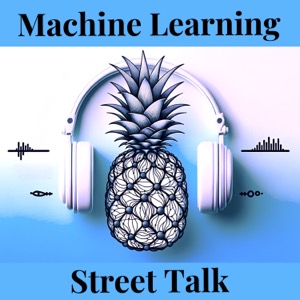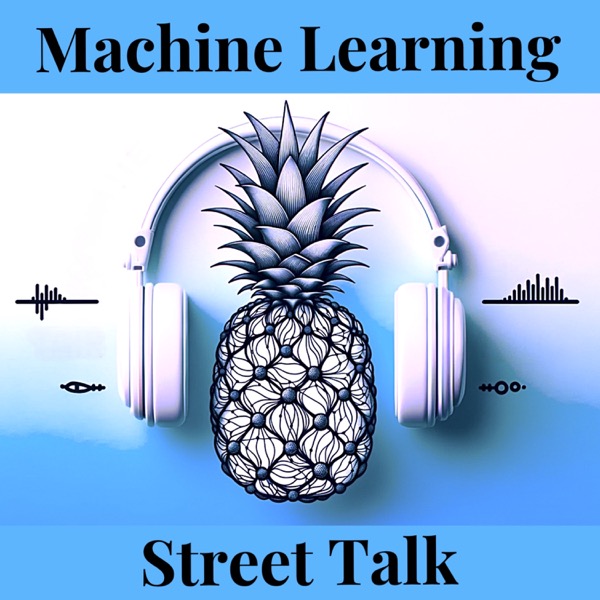Want to Understand Neural Networks? Think Elastic Origami! - Prof. Randall Balestriero
Machine Learning Street Talk (MLST) - En podcast av Machine Learning Street Talk (MLST)

Kategorier:
Professor Randall Balestriero joins us to discuss neural network geometry, spline theory, and emerging phenomena in deep learning, based on research presented at ICML. Topics include the delayed emergence of adversarial robustness in neural networks ("grokking"), geometric interpretations of neural networks via spline theory, and challenges in reconstruction learning. We also cover geometric analysis of Large Language Models (LLMs) for toxicity detection and the relationship between intrinsic dimensionality and model control in RLHF.SPONSOR MESSAGES:***CentML offers competitive pricing for GenAI model deployment, with flexible options to suit a wide range of models, from small to large-scale deployments.https://centml.ai/pricing/Tufa AI Labs is a brand new research lab in Zurich started by Benjamin Crouzier focussed on o-series style reasoning and AGI. Are you interested in working on reasoning, or getting involved in their events?Goto https://tufalabs.ai/***Randall Balestrierohttps://x.com/randall_balestrhttps://randallbalestriero.github.io/Show notes and transcript: https://www.dropbox.com/scl/fi/3lufge4upq5gy0ug75j4a/RANDALLSHOW.pdf?rlkey=nbemgpa0jhawt1e86rx7372e4&dl=0TOC:- Introduction - 00:00:00: Introduction- Neural Network Geometry and Spline Theory - 00:01:41: Neural Network Geometry and Spline Theory - 00:07:41: Deep Networks Always Grok - 00:11:39: Grokking and Adversarial Robustness - 00:16:09: Double Descent and Catastrophic Forgetting- Reconstruction Learning - 00:18:49: Reconstruction Learning - 00:24:15: Frequency Bias in Neural Networks- Geometric Analysis of Neural Networks - 00:29:02: Geometric Analysis of Neural Networks - 00:34:41: Adversarial Examples and Region Concentration- LLM Safety and Geometric Analysis - 00:40:05: LLM Safety and Geometric Analysis - 00:46:11: Toxicity Detection in LLMs - 00:52:24: Intrinsic Dimensionality and Model Control - 00:58:07: RLHF and High-Dimensional Spaces- Conclusion - 01:02:13: Neural Tangent Kernel - 01:08:07: ConclusionREFS:[00:01:35] Humayun – Deep network geometry & input space partitioninghttps://arxiv.org/html/2408.04809v1[00:03:55] Balestriero & Paris – Linking deep networks to adaptive spline operatorshttps://proceedings.mlr.press/v80/balestriero18b/balestriero18b.pdf[00:13:55] Song et al. – Gradient-based white-box adversarial attackshttps://arxiv.org/abs/2012.14965[00:16:05] Humayun, Balestriero & Baraniuk – Grokking phenomenon & emergent robustnesshttps://arxiv.org/abs/2402.15555[00:18:25] Humayun – Training dynamics & double descent via linear region evolutionhttps://arxiv.org/abs/2310.12977[00:20:15] Balestriero – Power diagram partitions in DNN decision boundarieshttps://arxiv.org/abs/1905.08443[00:23:00] Frankle & Carbin – Lottery Ticket Hypothesis for network pruninghttps://arxiv.org/abs/1803.03635[00:24:00] Belkin et al. – Double descent phenomenon in modern MLhttps://arxiv.org/abs/1812.11118[00:25:55] Balestriero et al. – Batch normalization’s regularization effectshttps://arxiv.org/pdf/2209.14778[00:29:35] EU – EU AI Act 2024 with compute restrictionshttps://www.lw.com/admin/upload/SiteAttachments/EU-AI-Act-Navigating-a-Brave-New-World.pdf[00:39:30] Humayun, Balestriero & Baraniuk – SplineCam: Visualizing deep network geometryhttps://openaccess.thecvf.com/content/CVPR2023/papers/Humayun_SplineCam_Exact_Visualization_and_Characterization_of_Deep_Network_Geometry_and_CVPR_2023_paper.pdf[00:40:40] Carlini – Trade-offs between adversarial robustness and accuracyhttps://arxiv.org/pdf/2407.20099[00:44:55] Balestriero & LeCun – Limitations of reconstruction-based learning methodshttps://openreview.net/forum?id=ez7w0Ss4g9(truncated, see shownotes PDF)

